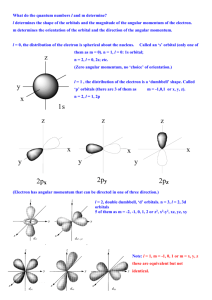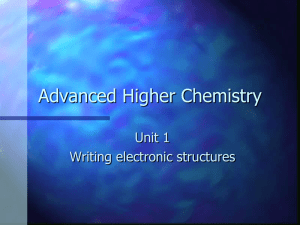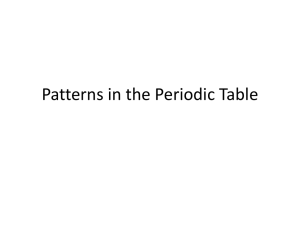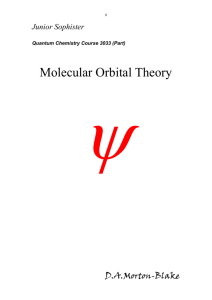FLORIDA INTERNATIONAL UNIVERSITY
advertisement
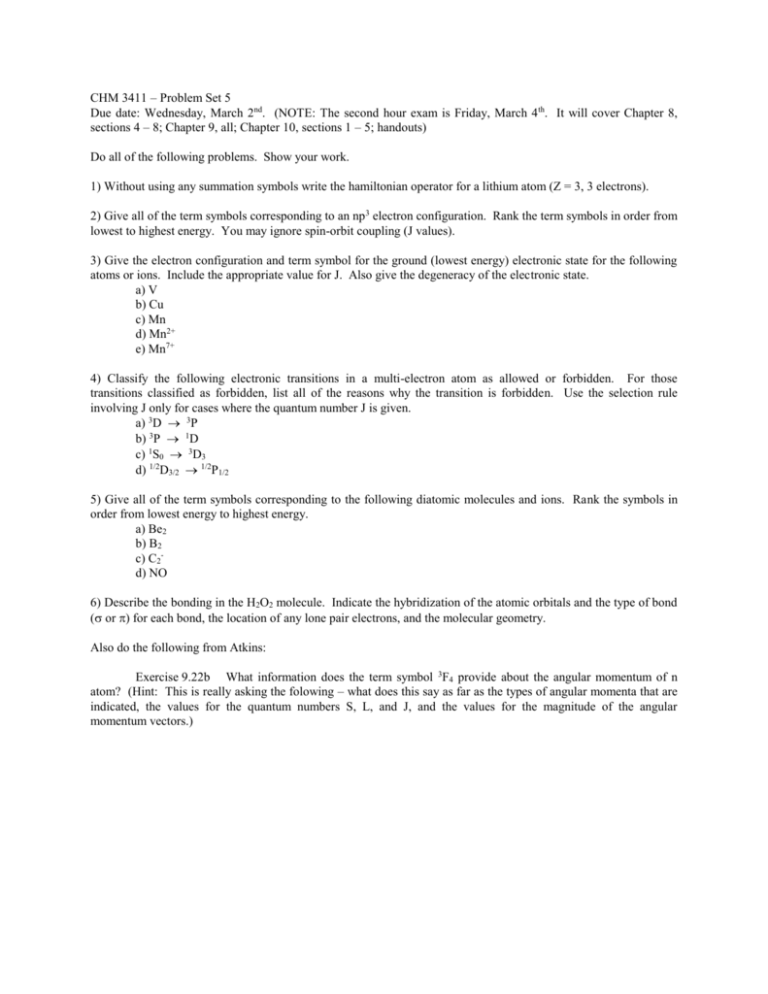
CHM 3411 – Problem Set 5 Due date: Wednesday, March 2nd. (NOTE: The second hour exam is Friday, March 4 th. It will cover Chapter 8, sections 4 – 8; Chapter 9, all; Chapter 10, sections 1 – 5; handouts) Do all of the following problems. Show your work. 1) Without using any summation symbols write the hamiltonian operator for a lithium atom (Z = 3, 3 electrons). 2) Give all of the term symbols corresponding to an np 3 electron configuration. Rank the term symbols in order from lowest to highest energy. You may ignore spin-orbit coupling (J values). 3) Give the electron configuration and term symbol for the ground (lowest energy) electronic state for the following atoms or ions. Include the appropriate value for J. Also give the degeneracy of the electronic state. a) V b) Cu c) Mn d) Mn2+ e) Mn7+ 4) Classify the following electronic transitions in a multi-electron atom as allowed or forbidden. For those transitions classified as forbidden, list all of the reasons why the transition is forbidden. Use the selection rule involving J only for cases where the quantum number J is given. a) 3D 3P b) 3P 1D c) 1S0 3D3 d) 1/2D3/2 1/2P1/2 5) Give all of the term symbols corresponding to the following diatomic molecules and ions. Rank the symbols in order from lowest energy to highest energy. a) Be2 b) B2 c) C2d) NO 6) Describe the bonding in the H2O2 molecule. Indicate the hybridization of the atomic orbitals and the type of bond ( or ) for each bond, the location of any lone pair electrons, and the molecular geometry. Also do the following from Atkins: Exercise 9.22b What information does the term symbol 3F4 provide about the angular momentum of n atom? (Hint: This is really asking the folowing – what does this say as far as the types of angular momenta that are indicated, the values for the quantum numbers S, L, and J, and the values for the magnitude of the angular momentum vectors.) Solutions. 1) Ĥ = - (/2me)12 - (/2me)22 - (/2me)32 - (3e2/40) (1/r1) - (3e2/40) (1/r2) - (3e2/40) (1/r3) + (e2/40) (1/r12) + (e2/40) (1/r13) + (e2/40) (1/r23) The terms can be grouped as electron kinetic energy Te = - (/2me)12 - (/2me)22 - (/2me)32 electron-nuclear potential energy Ven = - (3e2/40) (1/r1) - (3e2/40) (1/r2) - (3e2/40) (1/r3) electron-electron potential energy Vee = + (e2/40) (1/r12) + (e2/40) (1/r13) + (e2/40) (1/r23) 2) m = 1 m = 0 m = -1 ML MS 2 2 1 1 1 0 0 0 0 -1 1 0 0 0 0 -1 -1 -1 -2 -2 ½ -½ ½ -½ ½ 3 /2 ½ ½ -½ ½ -½ ½ -½ -½ - 3/2 -½ ½ -½ ½ -½ Note that there are (6!)/(3!)(3!) = 20 different arrangements. If we tabulate them, we get the following MS \ ML 3 /2 ½ -½ - 3/2 2 1 1 1 2 2 0 1 3 3 1 -1 -2 2 2 1 1 We now eliminate states by the following procedure. 1) Find the largest value for ML. 2) Find the largest value for MS for a state with the value for ML in 1. There is a state with L = ML and S = MS. 3) Write all of the possible values of ML and MS for the state found in 2. Eliminate one state for each possible combination of ML, MS. 4) If there are still states left, go back to step 1. So ML = 2, MS = ½ L = 2, S = ½ or 2D state g = 5 . 2 = 10 ML = 1, MS = ½ L = 1, S = ½ or 2P state g=3.2=6 ML = 0, MS = 3/2 L = 0, S 3/2 or 4S state g=1.4=4 The degeneracy for a particular term symbol is g = (2L + 1) (2S + 1). Notice we have 10 + 6 + 4 = 20 states, the same as the number of combinations of electron orientations. Based on Hund’s rules, the energy ordering of these states is 4 3) S < 2D < 2P a) V (23 e-) 1s2 2s2 2p6 3s2 3p6 4s2 3d3 = [Ar] 4s2 3d3 We only need to worry about partially filled orbitals. Using our rules for finding the lowest energy term symbol, we get m = 2 m = 1 m = 0 m = -1 m = -2 ML MS 3 3 /2 So ground state is L = 3, S = 3/2, or 4F state. g = 7 . 4 = 28 b) Cu (29 e-) 1s2 2s2 2p6 3s2 3p6 4s1 3d10 = [Ar] 4s1 3d10 Notice that promoting an electron from the 4s to 3d orbital makes the d orbital completely filled, and so the above is the correct configuration. We only need to worry about partially filled orbitals (so we don’t have to worry about the 3d orbital, as it is completely filled). Using our rules for finding the lowest energy term symbol, we get m = 0 ML MS 0 ½ So ground state is L = 0, S = ½, or c) Mn (25e-) 2 S state. g = 1 . 2 = 2 1s2 2s2 2p6 3s2 3p6 4s2 3d5 = [Ar] 4s2 3d5 We only need to worry about partially filled orbitals. Using our rules for finding the lowest energy term symbol, we get m = 2 m = 1 m = 0 m = -1 m = -2 ML MS 0 5 /2 So ground state is L = 0, S = 5/2, or 6S state. g = 1 . 6 = 6 d) We start with the electron configuration for Mn, and remove two electrons from the 4s orbital, to get Mn2+ (23e-) 1s2 2s2 2p6 3s2 3p6 3d5 = [Ar] 3d5 We only need to worry about partially filled orbitals. Using our rules for finding the lowest energy term symbol, we get m = 2 m = 1 m = 0 m = -1 m = -2 ML MS 0 5 /2 So ground state is L = 0, S = 5/2, or 6S state. g = 1 . 6 = 6 e) We start with the electron configuration for Mn, and remove two electrons from the 4s orbital and five electrons from the 3d orbital, to get Mn7+ (18e-) 1s2 2s2 2p6 3s2 3p6 = [Ar] All of the orbitals are completely filled, so L = 0, S = 0. The ground state (and in fact the only state) is 1S, with g = 1 . 1 = 1. 4) a) S = 0 is allowed, and L = -1 is allowed so ALLOWED b) S = -1 is forbidden, and L = 1 is allowed so FORBIDDEN c) S = 1 is forbidden, L = 2 is forbidden, and J = 3 is forbidden so FORBIDDEN d) S = 0 is allowed, L = -1 is allowed, and J = -1 is allowed so ALLOWED 5) The MO ordering for Be2, B2, C2-, and NO are as in Fig 10.34, page 386 of Atkins. g a) Be2 (4 valence e-) (1g)2 (1u*)2 1 b) B2 (6 valence e-) (1g)2 (1u*)2 (1u)2 The orbital is partially filled, and so we need to write down all of the possible arrangements of electrons. =1 States are = -1 M MS 2 0 0 0 0 -2 0 1 0 0 -1 0 = 2, S = 0 1 g = 0, S = 1 3 = 0, S = 0 1 g g Based on Hund’s rules, the energy ordering is 3g < 1g < 1g c) C2- (7 valence e-) (1g)2 (1u*)2 (1u)3 The orbital is partially filled, and so we need to write down all of the possible arrangements of electrons. =1 = -1 M MS 1 1 -1 -1 ½ -½ ½ -½ State is = 1, S = ½ u 2 d) NO (11 valence e-) (1)2 (1*)2 (1)4 (2)2 (1*)1 The * orbital is partially filled, and so we need to write down all of the possible arrangements of electrons. =1 = -1 M MS 1 1 -1 -1 ½ -½ ½ -½ States is = 1, S = ½ (No g/u symmetry label because this is heteronuclear diatomic) 2 6) Label the atoms as follows HA – OA – OB – HB HA 1sA AO OA h1A, h2A, h3A, h4A hybrid orbitals (sp3) OB h1B, h2B, h3B, h4B hybrid orbitals (sp3) HB 1sB AO Three valence bonds, between HA and OA (the 1sA AO and an hA hybrid orbital), OA and OB (an hA hybrid orbital and an hB hybrid orbital), and OB and HB (an HB hybrid orbital and the 1sB AO). Each oxygen has two remaining hybrid orbitals, each which contains a lone pair of electrons. Exercise 9.22b 3 F4 total spin S=1 total orbital L=3 total spin+orbital J = 4 |S| = (1.2)1/2 = (2)1/2 |L| = (3.4)1/2 = (12)1/2 |J| = (4.5)1/2 = (20)1/2


